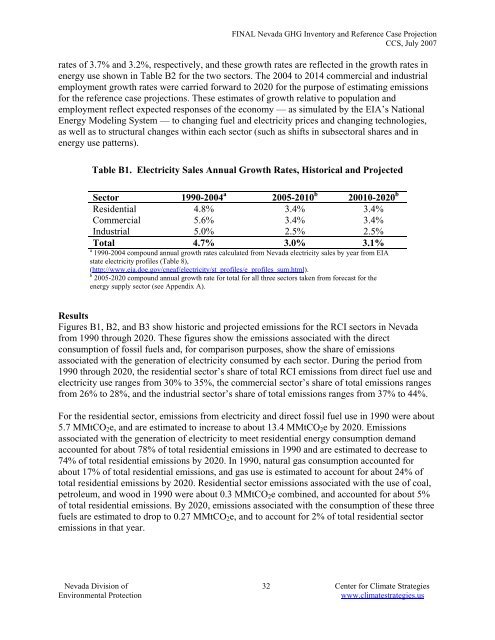Nevada Greenhouse Gas Inventory and Reference Case Projections
Nevada Greenhouse Gas Inventory and Reference Case Projections
Nevada Greenhouse Gas Inventory and Reference Case Projections
Create successful ePaper yourself
Turn your PDF publications into a flip-book with our unique Google optimized e-Paper software.
FINAL <strong>Nevada</strong> GHG <strong>Inventory</strong> <strong>and</strong> <strong>Reference</strong> <strong>Case</strong> Projection<br />
CCS, July 2007<br />
rates of 3.7% <strong>and</strong> 3.2%, respectively, <strong>and</strong> these growth rates are reflected in the growth rates in<br />
energy use shown in Table B2 for the two sectors. The 2004 to 2014 commercial <strong>and</strong> industrial<br />
employment growth rates were carried forward to 2020 for the purpose of estimating emissions<br />
for the reference case projections. These estimates of growth relative to population <strong>and</strong><br />
employment reflect expected responses of the economy — as simulated by the EIA’s National<br />
Energy Modeling System — to changing fuel <strong>and</strong> electricity prices <strong>and</strong> changing technologies,<br />
as well as to structural changes within each sector (such as shifts in subsectoral shares <strong>and</strong> in<br />
energy use patterns).<br />
Table B1. Electricity Sales Annual Growth Rates, Historical <strong>and</strong> Projected<br />
Sector 1990-2004 a 2005-2010 b 20010-2020 b<br />
Residential 4.8% 3.4% 3.4%<br />
Commercial 5.6% 3.4% 3.4%<br />
Industrial 5.0% 2.5% 2.5%<br />
Total 4.7% 3.0% 3.1%<br />
a 1990-2004 compound annual growth rates calculated from <strong>Nevada</strong> electricity sales by year from EIA<br />
state electricity profiles (Table 8),<br />
(http://www.eia.doe.gov/cneaf/electricity/st_profiles/e_profiles_sum.html).<br />
b 2005-2020 compound annual growth rate for total for all three sectors taken from forecast for the<br />
energy supply sector (see Appendix A).<br />
Results<br />
Figures B1, B2, <strong>and</strong> B3 show historic <strong>and</strong> projected emissions for the RCI sectors in <strong>Nevada</strong><br />
from 1990 through 2020. These figures show the emissions associated with the direct<br />
consumption of fossil fuels <strong>and</strong>, for comparison purposes, show the share of emissions<br />
associated with the generation of electricity consumed by each sector. During the period from<br />
1990 through 2020, the residential sector’s share of total RCI emissions from direct fuel use <strong>and</strong><br />
electricity use ranges from 30% to 35%, the commercial sector’s share of total emissions ranges<br />
from 26% to 28%, <strong>and</strong> the industrial sector’s share of total emissions ranges from 37% to 44%.<br />
For the residential sector, emissions from electricity <strong>and</strong> direct fossil fuel use in 1990 were about<br />
5.7 MMtCO 2 e, <strong>and</strong> are estimated to increase to about 13.4 MMtCO 2 e by 2020. Emissions<br />
associated with the generation of electricity to meet residential energy consumption dem<strong>and</strong><br />
accounted for about 78% of total residential emissions in 1990 <strong>and</strong> are estimated to decrease to<br />
74% of total residential emissions by 2020. In 1990, natural gas consumption accounted for<br />
about 17% of total residential emissions, <strong>and</strong> gas use is estimated to account for about 24% of<br />
total residential emissions by 2020. Residential sector emissions associated with the use of coal,<br />
petroleum, <strong>and</strong> wood in 1990 were about 0.3 MMtCO 2 e combined, <strong>and</strong> accounted for about 5%<br />
of total residential emissions. By 2020, emissions associated with the consumption of these three<br />
fuels are estimated to drop to 0.27 MMtCO 2 e, <strong>and</strong> to account for 2% of total residential sector<br />
emissions in that year.<br />
<strong>Nevada</strong> Division of 32 Center for Climate Strategies<br />
Environmental Protection<br />
www.climatestrategies.us
















